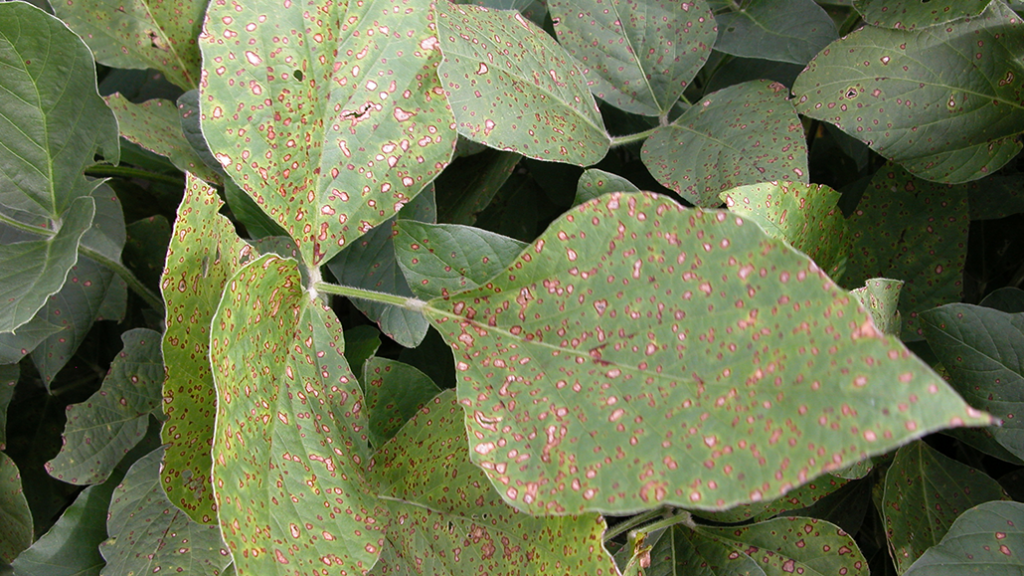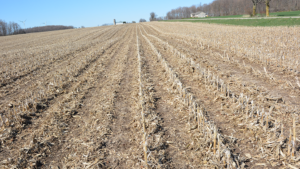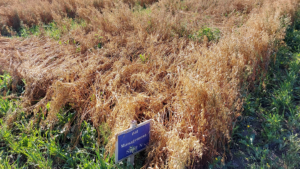Strobilurin fungicides
RESISTANCE A GROWING PROBLEM

MANY IMPORTANT FOLIAR fungal diseases — gray leaf spot and northern leaf blight in corn, for example, and frogeye leaf spot in soybeans — are controlled by foliar fungicides that contain strobilurin active ingredients. These include Headline, Quadris, Stratego, and Quilt.
But that control is, unfortunately, being eroded by resistance — which has already been found in Ontario.
An international organization called the Fungicide Resistance Action Committee (FRAC) reports that resistance to strobilurin fungicides has occurred in at least twenty-five fungal plant pathogens despite the relatively short time that this class of fungicides has been on the market. FRAC is a part of the Crop Protection Network, an international collaboration of public and private professionals (including Grain Farmers of Ontario) that helps monitor and manage field crop pests and diseases.
Strobilurin, DMI, SDHI, and other fungicide classes control more than diseases. Indeed, the strobilurins group controls an unusually-wide array of pathogenic fungi, including water molds, downy mildews, powdery mildews, leaf spotting, and rusts.
Strobilurins also enhance plant growth and yield in some cases. They promote net carbon assimilation, nitrate reductase enzyme activity, stress tolerance, and hormonal balance.
In terms of their mode of action on fungal pathogens, strobilurins inhibit respiration in the mitochondria of fungal cells.
However, fungal pathogens with a mutation that allows them to resist this mode of action have already been found across much of the Midwest and the southern United States, and generally through the northern U.S. soybean production areas of Ohio, Michigan, and other nearby states.
RESISTANCE PRESENCE
Here in Ontario, Albert Tenuta, field crop pathologist at the Ontario Ministry of Agriculture, Food & Rural Affairs (OMAFRA) and Katie Goldenhar, OMAFRA horticultural crop pathologist, are currently running a project to build capacity to monitor and detect resistance in strobilurin fungicides and other fungicide groups.
“It’s a two-year project under the Canadian Agricultural Partnership funding program that started last fall, and we are looking at the Cercospora group of fungal diseases such as frogeye leaf spot in soybeans, as well as some others,” Tenuta says. “Resistance to fungicides is a new issue. The horticulture and greenhouse sector have already had to deal with resistance, but it’s new to the field crop sector.”
Partners in the project include Ontario-based researchers such as Dr. Owen Wally at Agriculture and Agri-food Canada and U.S.-based researchers such as Dr. Carl Bradley at the University of Kentucky.
The team will validate protocols to monitor and actually monitor diseases which have shown resistance to strobilurin, triazole, and other fungicides. Tenuta explains that this will provide a baseline for the crop sector in Ontario, allowing historical comparisons to determine if resistant pathogen populations are increasing over time. This information can also be used to prolong the effectiveness of foliar fungicides in Ontario field crop production.
That baseline has already been established in a preliminary way in Ontario with frogeye leaf spot. Wally has analyzed several isolates this year and found resistance to strobilurin (he found the mutation called G142A that’s the one of concern for frogeye leaf spot in soybeans and other fungal diseases like Northern leaf blight in corn).
“The good news from an Ontario perspective with regard to frogeye leaf spot is that although it did well last year due to the moisture, we’ve seen a reduction in the last seven or eight years due to breeding efforts,” says Tenuta. “There are still varieties that are susceptible, but at the same time, we have fungicides for sclerotinia and white mold that work for frogeye as well.”
The project also aims to develop Ontario labs’ capacity to process samples and the analytical protocols required to monitor fungicide resistance. “This expertise is not available in Ontario, and it is critical that we have it to monitor resistance development in the province,” Tenuta explains. “The need for Ontario expertise is also necessary since the movement of biological samples across the border has become more complicated, and delays in analysis often result in live samples being unusable.”
In addition, these protocols are transferable to other agricultural sectors, and expertise developed in Ontario can be of potential service to other provinces.
CAUSES OF RESISTANCE
Overuse of fungicide products containing strobilurin has been blamed for resistance development, but in resistance to fungicides like Headline in Tennessee and other U.S. states, the fields in question did not have a history of overuse.
“The first thing investigated was management practices and potential overuse,” explains Tenuta, “but they started with frogeye leaf spot to isolate the resistant wild type and found that it was quite common in the soybean-producing areas of the U.S. So, selection for more resistance has been happening in endemic resistant populations — those that were already there.”
CONTROLLING RESISTANCE
As with herbicide resistance, growers can avoid contributing to the development of fungicide resistance by scouting to ensure proper fungicide selection and applying fungicide only when necessary and in response to increased disease risk.
“With foliar diseases in soybeans or any crop, we need to understand the disease risk and the pathogen parameters, what it likes and what it doesn’t like,” says Tenuta. “With frogeye and white mold in soybeans, these pathogens like wetter or cooler or moderate conditions, and the risks are different every year and can be different regionally as well in Ontario.”
Scouting is important before R1 to full flower to pod set in soybeans and starting before tasselling in corn. Ensure your disease identification is correct so that your product selection is correct. Scout fields again within two weeks after any foliar fungicide application to determine if the fungicide is adequately managing the disease.
Mixed modes of action in fungicides are available now, which helps with disease control but also reduces the selection pressure for resistance to develop, says Tenuta. “And don’t go below label rates,” he says. “The label rates are established to be consistently effective over time and should be closely followed.” •

























